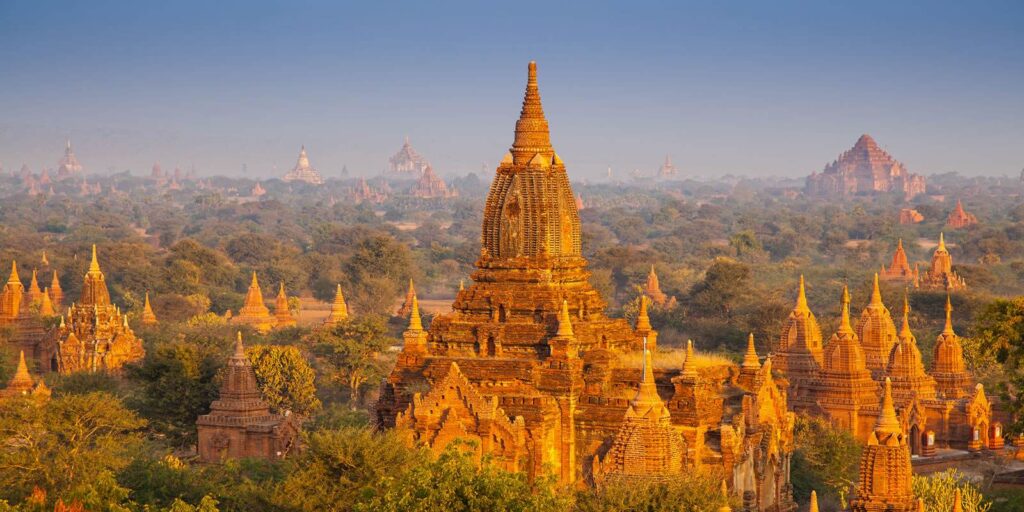Bagan, Myanmar – Travel Tips
Category
Categories
Popular Articles

**Overview of the Destination**
Located in the Mandalay region of Myanmar, Bagan is a historical city known for its sprawling landscape of over 2,000 religious edifices, including temples, monasteries, and stupas. It’s famed as the heart of Myanmar’s rich cultural and historical heritage, boasting of an architectural cluster that’s a dream for lovers of history, culture, and art. Whether you climb to the top of a pagoda for a mesmerizing sunset or explore the ancient ruins by horse cart, Bagan is an enthralling destination that warrants a visit.
**Best Time to Visit**
The best time to visit Bagan is during the dry season, which runs from November to February. This period affords comfortable temperatures for exploration and clearer skies for those unforgettable sunrises and sunsets. A notable event to consider when planning your trip is the annual Ananda Pagoda Festival in January. During this religious and cultural event, you’ll witness almsgiving, traditional dances, and markets teeming with local goods. While the monsoon season (June to October) presents fewer tourists, heavy rainfall and poor road conditions can pose travel challenges.
**Climate & What to Pack**
Bagan experiences a tropical climate with three chief seasons: hot, rainy, and cool. With temperatures soaring between March and May, be sure to pack light, breathable clothing, sunscreen, and a hat. The rainy season brings heavy, unpredictable downpours, so umbrellas and raincoats are essential. Cool season (November to February) sees pleasant daytime temperatures, so typical travel clothes will suffice. However, pack a light jacket or sweater for chilly evenings and mornings.
**Getting There**
Yangon and Mandalay international airports are the closest major airports to Bagan. From there, you can take a domestic flight to Nyaung-U Airport, just a few kilometers away. Alternatively, buses and trains are available, although travel times are significantly longer. Tourist visas are required for most nationalities, so be sure to check and process your visa requirements ahead of time.
**Getting Around Locally**
Bagan is easy to explore via various transportation modes. Horse carts and bicycles are a traditional way to get around, while renting e-bikes or electric scooters allows for efficient exploration. Taxis are available but may be pricier, especially when accessing more remote temple sites.
**Safety Tips**
Bagan is generally safe for tourists, including solo travelers. However, as with any travel destination, common sense and vigilance are advised. Do avoid the unmanned temples at dark, restrict from climbing pagodas for safety, and ensure your rented transportation is in good condition. Also, respect the local customs – dress modestly, especially when visiting temples.
**Top Things to Do & See**
Aside from exploring the breathtaking temples, like the Ananda Temple and Shwesandaw Pagoda, experience a tranquil sunrise hot-air balloon ride. A visit to the Bagan Archaeological Museum is a must for history enthusiasts. Immerse yourself in local culture through lacquerware workshops, local markets, and a boat trip along the Irrawaddy River.
**Where to Stay**
Bagan offers a wide range of accommodations. For luxury seekers, Aureum Palace Hotel and Resort Bagan offers stunning views amidst comfort. Mid-range options like Bagan Thiripyitsaya Sanctuary Resort present great amenities without breaking the bank. Budget travelers can consider the Ostello Bello Bagan, known for its sociable atmosphere. The areas around Old Bagan and Nyaung-U are preferable for their proximity to major attractions.
**Food & Local Cuisine**
Bagan offers an interesting culinary scene. Try local delicacies like Mohinga, a traditional fish soup served with rice noodles, and Laphet, a pickled tea leaf salad. Numerous eateries around Anawrahta Road, the Bagan Foodl Village, and the Nyaung U market serve such local fare amidst a vibrant atmosphere.
**Cultural & Practical Tips**
The official currency in Myanmar is the Kyat (MMK), and the national language is Burmese, although English is understood in most tourist areas. Tipping is not compulsory but appreciated for good service. Electricity is 230V with type C, D, and G plugs. Free Wi-Fi can often be found in cafes, hotels, and guesthouses but don’t expect high-speed connections.
**Sustainable or Responsible Travel Tips**
Respect for the cultural heritage of Bagan is of paramount importance. Do not climb on the pagodas, and when visiting temples, dress respectfully with knees and shoulders covered. Avoid contributing to beggar economies, especially involving children. Instead, consider supporting local communities through responsible tourism initiatives, like buying from local artisans and consuming at locally owned enterprises.
Remember, one visit to Bagan never seems enough to discover all that this enchanting city has to offer. Each day brings a new sunrise, a different temple, and another unforgettable snapshot of life in this timeless land.










